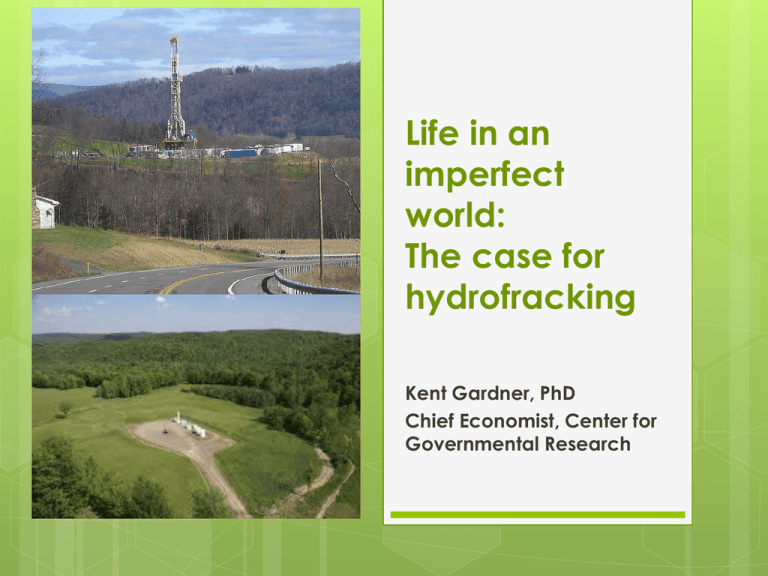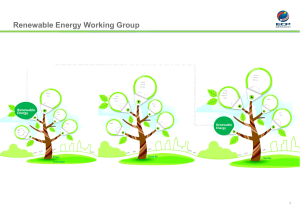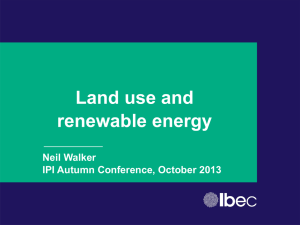Life in an imperfect world: The case for hydrofracking
advertisement

Life in an imperfect world: The case for hydrofracking Kent Gardner, PhD Chief Economist, Center for Governmental Research No free lunch Total consumption of electricity will rise as global incomes rise: U.S. per capita consumption is 3.4x that of China Alternative sources of energy remains persistently more costly than energy from fossil fuels, particularly shale gas Hydrofracking has driven down natural gas price, reducing the cost of home heating & electricity generation Shale gas displaces Foreign energy sources—IEA predicts U.S. energy independence Coal—worse in human & environmental terms These rewards don’t come without risk Gee, Iris . . . Levelized Cost per MWh Natural Gas… Hydro Wind Fuel Geothermal Capital Coal w CCS OTHER Nuclear Source: U.S. Energy Information Admin Biomass Solar PV Solar Thermal $0 $50 $100 $150 $200 $250 The cost of energy matters 10% 9% Share of Income Spent on Electricity 2011 Consumer Expenditure Survey 8% 7% 6% 5% 4% 3% 2% 1% 0% Lowest 20 % Second 20 % Third 20 % Fourth 20 % Highest 20 % The cost of energy matters 12% 10% Share of Income Spent on Gasoline 2011 Consumer Expenditure Survey 8% 6% 4% 2% 0% Lowest 20 % Second 20 % Third 20 % Fourth 20 % Highest 20 % Environmental Benefits (from Environmental Defense Fund briefing paper) Exchanging natural gas for coal can cut conventional air pollution, help reduce greenhouse gas emissions from the power sector Half the carbon dioxide of coal when burned Third as much of the nitrogen oxides that come from burning coal Almost none of the mercury and sulfur dioxides from burning coal or oil Could end mountaintop removal mining and other environmentally disastrous industry practices Natural gas-fired power plants can cycle up quickly, they can be a nimble enabler of intermittent renewable energy sources in combination with demand response and emerging large-scale energy storage technologies Other Shale Gas Benefits (from Environmental Defense Fund briefing paper) Job creation: Rising demand for technical and prof services, for steel, pipelines and storage facilities, ancillary goods and services Expansion in the American chemical industry, with Dow and DuPont now building new plants close to shale formations Revival in U.S steelmaking and other manufacturing industries. Nucor, which uses natural gas to make steel, is building a $750million facility in Louisiana, just eight years after shutting down a similar plant in the same state Potential U.S. energy independence and enhanced energy security Health Impacts Claims of health impacts of hydrofracking are disputed in the public record Health consequences of coal mining are undisputed Deaths Permanent disability (full/partial) Mountaintop removal, impact of spoils 60 Coal Fatalities 06-10 avg: 383 accidents resulting in permanent disability 50 40 30 20 10 0 Annual average: 32 Source: Mine Safety & Health Admin 00 01 02 03 04 05 06 07 08 09 10 11 12 Health Impacts: HVHF Cuomo Administration has been dragging its feet on a hydrofracking ruling—why? 2012 DEIS from NYS DEC concludes that "by implementing the proposed mitigation measures identified and required in this (report), the department expects that human chemical exposures during normal HVHF operations will be prevented or reduced below levels of significant health concern. Thus adverse impacts on human health are not expected from routine HVHF operations. When spills or accidents occur, the department has identified numerous additional mitigation measures ... so that significant exposures to people and resources on which they rely are unlikely." These are DRAFT findings—but clearly reflect considerable sentiment within DEC that hydrofracking can be effectively regulated Climate Change Impact Displaces coal—reduction in GHG Ingraffea disputes this point, but his paper (Howarth et al) has been challenged by other scientists A commentary on “The greenhouse-gas footprint of natural gas in shale formations” by R.W. Howarth, R. Santoro, and Anthony Ingraffea Lawrence M. Cathles III & Larry Brown & Milton Taam & Andrew Hunter Deutsche Bank Climate Change Advisors , posted by Worldwatch Institute Climate Change Impact Displaces coal—reduction in GHG Ingraffea disputes this point, but his paper (Howarth et al) has been challenged by other scientists • Environmental Defense Fund & Worldwatch Institute support proposition that shale gas reduced GHG emissions by displacing coal What’s the policy response? Regulation of HVHF practice Tax the bad, don’t subsidize single solutions Learn more Regulation & voluntary compliance Tentative agreement on voluntary regulation reached with drillers, EDF & regulators Data suggests that compliance improves when small firms displaced by major energy firms Policy response: Be careful what you wish for Subsidies for corn ethanol continue through Renewable Fuel Standard, although explicit subsidy expired 40% of corn crop to ethanol (price increased fourfold since 2005) Meeting 36m gallon RFS goal by 2022 would require entire field corn crop Thanks to the Iowa Caucuses? Policy response: Be careful what you wish for Europe’s “Renewable Fuel Standard” subsidized renewable fuels What’s “renewable”? Europe declared wood to be “renewable” for its RFS—why not? Credit worth $68/MWh Back to Iris . . . Natural Gas… Cost per MWh $66 Hydro $90 Wind $97 Geothermal $100 Coal w CCS $100 Nuclear $113 Biomass Source: U.S. Energy Information Admin $52 Solar PV $157 Solar Thermal $251 $0 $50 $100 $150 $200 $250 Policy response: Be careful what you wish for Europe’s “Renewable Fuel Standard” subsidized renewable fuels What’s “renewable”? Europe declared wood to be “renewable” for its RFS—why not? Credit worth $68/MWh Canadian hardwood prices up 60% since 2011 Policy response:Be careful what you wish for Solyndra’s ½ B loan guarantee? Electric car subsidies: Transfer from poor to rich? Economists solution: Tax what you don’t want, don’t subsidize what you think you do More study EPA/Interior/Energy agree in April 2012 to work together to improve knowledge EPA studying drinking water implications through multiple studies and exhaustive analysis of the data Let the numbers speak











